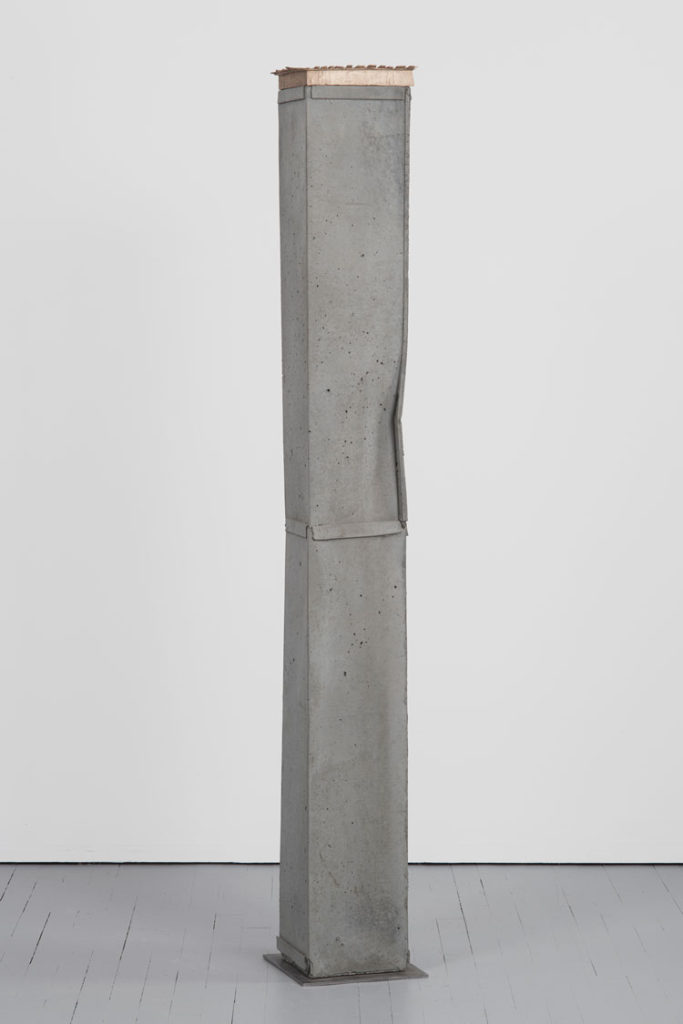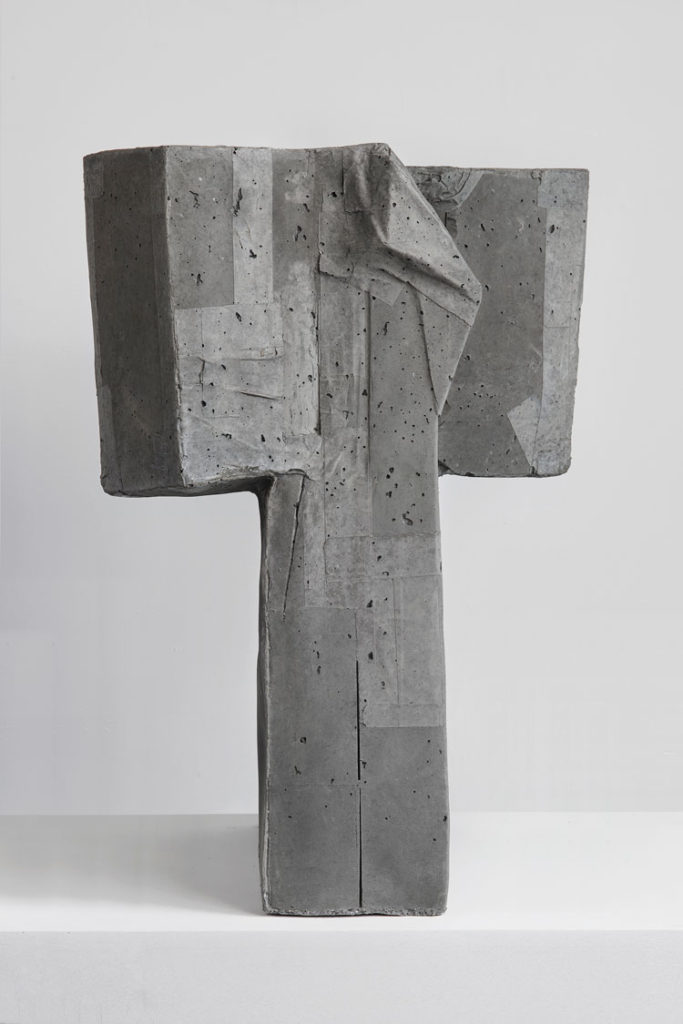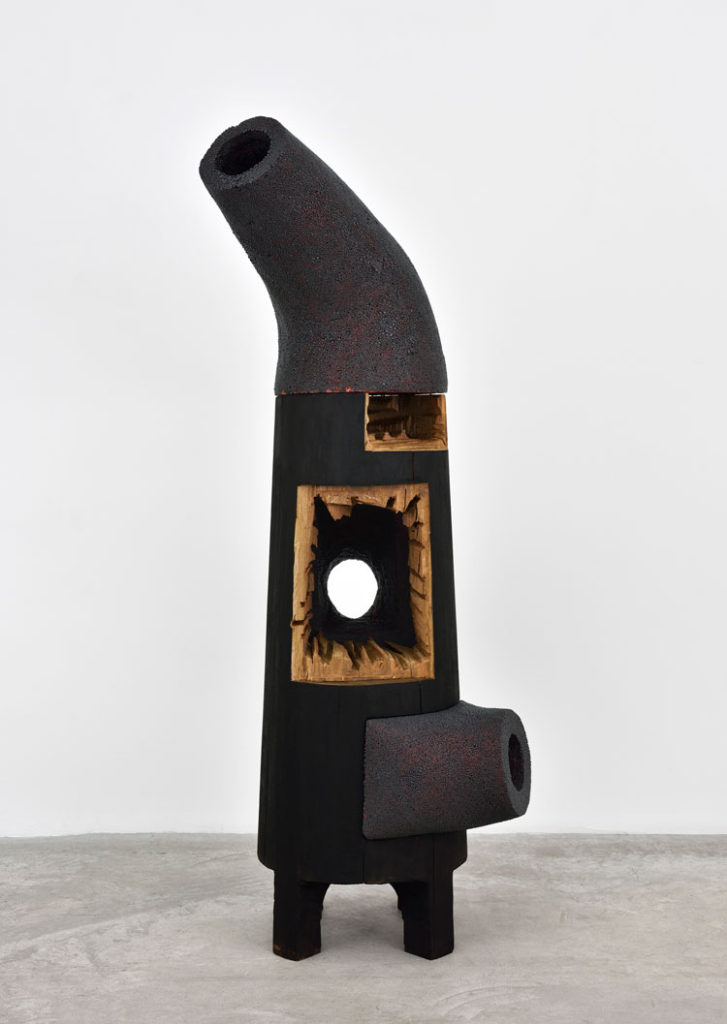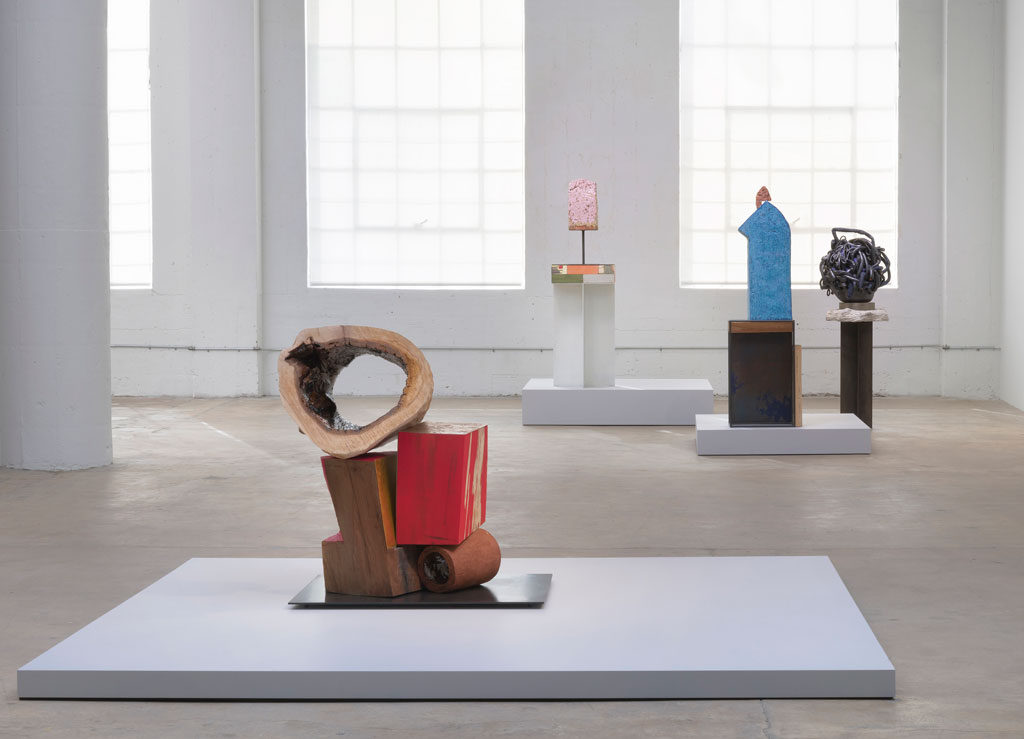In the world of Arlene Shechet (NA 2016), the gallery is a royal court. In her current solo exhibition at Susanne Vielmetter Los Angeles Projects, The Queen, a concrete tower with a bronze crown and steep indentation in her torso, like a wound sustained in battle, stands tall among her subjects. They’re a group of sculptures that evoke characters with complex and contrasting identities. A mix of natural and industrial, hand-worked and ready-made, vibrant and monochrome, the works in Arlene Shechet: Sculptures highlight the artist’s ongoing dialogue with her creations.

Shechet’s playful works embody gestures and jesters. To get a full view, one has to encircle the sculptures and twist, bend, or turn to discover all the details. There are cut-outs, glazes, and joinings that can only be discovered while standing at certain angles, and the perspective shifts dramatically based on the viewer’s position.
One piece, Twins, looks like a monolithic capital “T” when viewed straight-on, but a sidestep reveals that it is two separate concrete sculptures, incredibly balanced upright, despite their top-heavy structure. Movement doesn’t just reward you with this visual fissure: step even closer and you’ll find rigid lines, organic folds, and subtle contrasts within the coloration that Shechet created by applying and stripping tape to the concrete. Twins, like all the works in the exhibition, takes a long time to digest, and new details emerge with every additional look.

Many sculptures take on a bipedal, humanoid presence. They’re vertically oriented, either tall from top to bottom, or lifted on pedestals to meet your eye. Shechet describes these as “haptic sculptures,” meaning that they evoke body language, and their purposeful person-sized height draws a bodily relationship with the viewer. With Fictional Exchange, a crumbling block of pink glazed firebrick is poised on a thin metal rod, suggesting a slight tilt of the head. It’s easy to imagine it regarding us curiously, with its lumpy surface and patchy glaze making its head appear like an exposed brain, synapses firing. Personifying a sculpture and giving it the guise of higher thought creates an empathetic language between object and viewer. The human touches help project an emotional connection onto pieces like Fictional Exchange, Twins, and The Queen.
From the alien to the more traditional sculptural forms, it is often their titles that bring them to life. There are abstract creatures such as Deep Listening, which has snout-like ears and a carved tunnel piercing through its body, and Show Off, a ceramic piece that resembles a sea anemone with waving tentacles. One of the most formalist works, a brutalist steel and bronze cubic tower, is called Without Name, rather than “untitled,” which likens the sculpture to a stray animal, unclaimed. Another piece that lacks a familiar, organic form, but is granted livelihood through its title, is Double Oculus, which has two hollow sections—one is a slice of a tree trunk that grew with a hole in the center, the other an annular ceramic piece. Shechet has preserved the inner bark by coating it in resin, but carved away the outer bark; the other section has a thick glaze lining the inside, which mimics the color and texture of the resined bark. By using the word “oculus,” those voids are transformed into watchful eyes, tracking every step through the queendom.

There are 19 works in the show, which could feel crowded, but Vielmetter takes advantage of her new, 11,000 square foot space in Downtown Los Angeles to give people room to walk around the works and digest them from every angle. Shechet herself was involved in the staging, viewing the floor plan as another integral piece of her sculptures’ compositions. The curator and artist ensure that if you stand far from the objects, you will see them as a cluster, drawing motifs that carry from one item to the next, like seafoam green paint, or a beaded glaze texture. But when you stand quite close to the works, you also hone in on their individual idiosyncrasies, like the long terracotta staff that dives into the belly of a slightly askew, but otherwise sturdy, ceramic chimney that adorns Unpredicted.

There’s a lot to uncover while looking at Shechet’s characters, and the spacious gallery privileges those who like to amble. One way to take in this show is to imagine the viewing experience as a call and response, shifting your steps to accommodate each sculpture’s persona, then moving again when another angle reveals an entirely different identity. In Shechet’s palace, there are many subjects to meet and admire, and each contains multitudes.
Arlene Shechet: Sculptures is presented at the Downtown location of Susanne Vielmetter Los Angeles Projects April 6 – June 8, 2019.
Renée Reizman is an interdisciplinary curator, artist, and writer at the crossroads of social and critical spatial practice. Reizman embeds herself in communities to identify object-oriented networks that shape culture and society.
